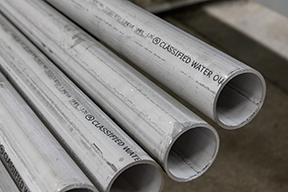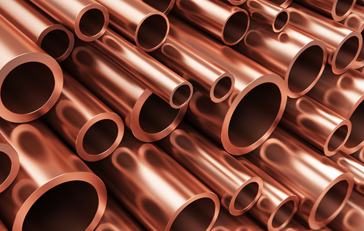When you're looking at a range of pipe or tubing options, you may have a lot of questions. What is IPS pipe meaning? Standing for Iron Pipe Size, IPS was originally based on the inside diameter of pipe, known as the ID; and therefore, the original sizing system for pipe. However, nominal pipe size (NPS) has become the overarching standard, and is based on the outside diameter. IPS (Iron pipe size) is still widely used today throughout the industry when referring to pipe.
Many other individuals may ask what is CTS pipe size? Standing for Copper Tubing Size, CTS measures copper tubing, which often has a different outside diameter (OD), and has a different wall thickness than IPS.
While IPS and CTS are both common terms in the Pipe, Valves and Fittings (PVF) industry, they mean completely different things. A 1” IPS pipe is not the same as a 1” CTS pipe. IPS pipe will not work with CTS fittings, and CTS pipe will not work with IPS fittings. If joining two different piping systems is required, special care must be taken, and special adapters must be used. For additional information, please contact your Merit Brass Co. representative.
What is iron pipe size? Iron Pipe Size is used when describing any piping system constructed of carbon steel, or stainless steel pipe. As we stated earlier, iron pipe size is based on the outside diameter, but for sizes 12" and below the outside diameter does not match the exact measurement it's labeled as. For example, a 1" IPS has an outside diameter of 1.315", while a 12" iron pipe has an outside diameter of 12.75".
outside diameter, but for sizes 12" and below the outside diameter does not match the exact measurement it's labeled as. For example, a 1" IPS has an outside diameter of 1.315", while a 12" iron pipe has an outside diameter of 12.75".
For sizes IPS pipe 14" and above, the outside diameter is equal to the nominal size meaning a 14" IPS pipe will have an OD of 14"; and a 16" IPS pipe will have an OD of 16".
Pipe comes come in a wide range of sizes and schedules. A schedule is the wall thickness of the piping. When the schedule increases, the thickness of the wall also increases. As an example, schedule 80 pipe has a thicker wall than schedule 40, making it stronger and able to hold up to higher pressures.
There are several schedules available for IPS systems. An example of a few includes: schedule 5, schedule 10, schedule 40 (which is generally the most common), schedule 80 (traditionally deemed extra heavy or extra strong), schedule 160 (also known as double extra strong).
Another schedule that you may come across is known as “schedule 7”. This schedule is not a formally recognized schedule in ANSI A53 (Standard Specification for Pipe, Steel, Black and Hot-Dipped, Zinc-Coated, Welded and Seamless), but a term given to any number of specialty pipe designed for use in Fire Suppression Systems. These pipes generally have a wall thickness between schedule 5 and schedule 10, and some have special coatings to help with the water flow through the pipe.
What is Copper Tube Size? How do you measure copper tube size? The first thing to understand is that Pipe and Tube are different. Tubes are classified by their actual dimension, meaning their outside diameter and wall thickness are the actual dimension. Tubes can be round, square and rectangular; as well as also being to much tighter dimensional tolerances.
 Copper tubing is a sub-set of tubing, but follows the dimensional characteristics of pipe. The outside diameter and wall thickness of copper tubing are not the actual dimensions. Much like IPS schedules, the wall thickness of copper tube is available in several types including: Types K, L, and M, which represent the different wall thicknesses. It is important to note that there is also copper pipe in the pipe, valve & fitting (PVF) industry, which can have some differences from copper tubing and copper tube size.
Copper tubing is a sub-set of tubing, but follows the dimensional characteristics of pipe. The outside diameter and wall thickness of copper tubing are not the actual dimensions. Much like IPS schedules, the wall thickness of copper tube is available in several types including: Types K, L, and M, which represent the different wall thicknesses. It is important to note that there is also copper pipe in the pipe, valve & fitting (PVF) industry, which can have some differences from copper tubing and copper tube size.
Type K copper tubing has the thickest of walls as compared to its counterparts. There are several industrial, commercial & residential plumbing applications where type K plays a role such as: gas, oxygen, steam, plumbing, heating, water.
Type L copper tubing is an average wall and is thinner than type K but not as thin as type M. Type L copper tubing is used in commercial and residential plumbing including HVAC applications, interior plumbing and fire protection.
Type M is the least expensive of Type K,L and M because of its thinner wall (less copper). It is commonly used in applications around light commercial and residential plumbing such as domestic water service and vacuum systems.
The fourth type of copper tubing is known as DWV, drain/waste/vent. The Type DWV has an even thinner wall thickness than Type M and is therefore less expensive. It is used in unpressurized applications.
Is copper tube size (CTS) ID or OD? Copper tubing is always measured by the outer diameter (OD). The OD is 1/8” larger than nominal pipe size. As an example 0.5” CTS is equal to an OD of 0.625”.
The inner diameter or ID of copper tubing is dependent upon the type of copper tubing that is being used. There are 4 types of copper tubing: K, L, M ad DWV.
Overall, the decision to go with pipe or tubing is a choice that will be based on your project's needs, available space, engineering specifications, and budget.
Not certain whether copper tube or pipe is best for your piping system and its application? The experienced professionals at Merit Brass are always happy to help. Please feel free to contact us today for more details, if you have any questions, or to discover our extensive offering of piping components.
Speak with a Merit Expert Today!
Author: Kimberly Wallingford, Merit Brass' Director of Marketing and Marcus Estrella, Merit Brass' Director of Product LIne Management
https://www.engineeringtoolbox.com/cts-copper-tubing-sizes-d_2112.html
https://www.engineeringtoolbox.com/ansi-steel-pipes-d_305.html
https://www.engineeringtoolbox.com/copper-tubes-dimensions-pressure-d_84.html
https://www.copper.org/applications/plumbing/cth/standard-tubes/cth_1stand_type.html
https://www.jtcmetals.com/blog/tube-vs-pipe-the-differences-explained-in-plain-english/
https://blog.thepipingmart.com/metals/copper-pipe-vs-tube-whats-the-difference/
https://blog.thepipingmart.com/metals/steel-pipe-vs-copper-pipe-whats-the-difference/
https://www.copper.org/applications/plumbing/techref/tpf_stds/tube_pipe_stds.html
https://usaindustries.com/piping-isolation-testing-products/pipe-schedule-chart/
Copper Tubes Type K - Dimensions and Physical Characteristics (engineeringtoolbox.com)
(2) The Most Common Types of Copper Tube: K/L/M | LinkedIn
2/11/2025 11:50:01 AM